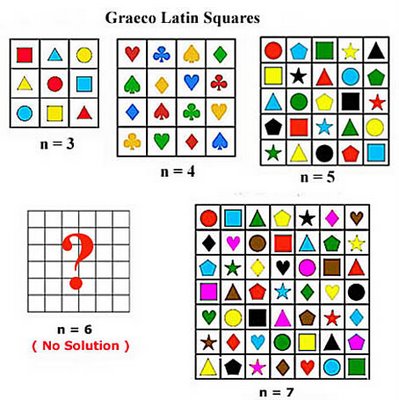36 OFFICERS PROBLEM - Part 3

In Part 2, we annunciated Euler’s “36 Officers Problem. In spite of much experimentation, he was unable to discover a Latin-Graeco square of order 6. He was also unable to prove that it did not exist. He therefore made the famous conjecture, which meant that:
“ There does not exist such a Latin-Graeco Square whose order has the form
n = 4k + 2 ”
In the first case of k = 0: n=2 is trivially impossible. The next case k = 1: n=6 is, according to Euler’s conjecture, impossible and so also cases where n= 10, 14,18, 22,26 …. etc are impossible. This conjecture went unsolved for over 100 years. In1900, a French mathematician, Gaston Terry checked every possible combination for a 6 x 6 Euler square and showed that none existed, partly proving Euler’s conjecture.
Finally in 1960, Bose, Shrikhande and Parker managed to prove that Euler squares (i.e. Latin-Graeco squares) exist for all orders except for n=6. (and obviously form=2)
The Euler Square which is shown on the left where n = 10, which for 177 years had been believed to be impossible was finally constructed by Parker in 1960.Here in each column and in each row each color of the outer square and each colour of the inner square occurs only once. No combination of 2 colours occurs twice.




